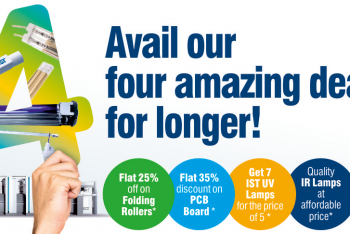The Keys to Successful Preventive Maintenance
Successful preventive maintenance is about sticking to a process. It involves discipline, knowledge and effective implementation. We call this a proactive approach rather than a reactive approach towards maintenance
The machine has broken down and production has come to a standstill. The reason? Lack of maintenance, which results in such unscheduled stoppages! Now, all the maintenance activities which haven’t been carried out regularly in the past few months will be carried out in this period of downtime.
This is not an unusual state of affairs. In fact, this is how most presses tackle their maintenance needs. Maintenance activities are restricted to downtime maintenance of the machines. In other words… a reactive approach towards such situations.
However, there is a need to increase awareness about the need for preventive maintenance. As the saying goes, prevention is better than cure! Preventive maintenance is critical for the efficient running of your press. Some of the basics of successful preventive maintenance are discussed below.
Stick to a schedule
Sticking to a schedule is essential. This covers the following broad areas: a) proper scheduling of work, b) no violation of schedules, c) equal priority for production and maintenance, d) aggressive monitoring, and e) proper recording of history.
To put it in a nutshell, what you need to do is ‘predictive maintenance’, since you can ‘predict’ the performance of the machine by means of regular maintenance. You need to ensure that a proper schedule is worked out for maintenance, and that it is not violated. This can be implemented by, for example, fixing a specific day in the month for all major maintenance-related activities. This has to be established as sacrosanct among all the people that handle the press. First, the management needs to understand that maintenance is as important as production, and has to be monitored as aggressively as production. Most press owners tend to take maintenance lightly, because they don’t want to interrupt production. In practice, the whole team should take an aggressive stance in favor of timely maintenance.
Also, the proper recording of events can make it easy to streamline maintenance activities. For example, a simple checklist of what has been done and what remains to be done can be a great help in making maintenance activities quicker and easier for everyone involved.
Bring in the best
If you want your press to deliver the best quality, you must also use only the best materials while carrying out maintenance tasks. Some of the basics here include: a) selection of proper cleaning agents, b) selection of proper lubricants, c) availability of original spare parts, and d) special gauges and tools for repairs.
The selection of proper cleaning agents and lubricants decides the efficacy of maintenance. By not using the recommended ones pushes your machine to unnecessary wear and tear, leading to frequent breakdowns. This ultimately leads to loss of production and hence loss of revenue. So, you must understand that trying to save cost on cleaning agents and lubricants only increases your overall maintenance cost.
In the same way, it makes a huge difference to your machine whether you use original spare parts or not. Original spare parts not only have a longer life span, they also enhance the efficiency of the machine.
Often, the management decides to cut down on maintenance expenses, forcing press operators to make do with materials and equipment which are below par. This approach only results in lowering the productivity of the press. You should not hesitate to employ special gauges and tools for repairs, or other equipment, as the need may be. A makeshift arrangement will only postpone the problem with your machine instead of resolving it. Adopting the best practices in maintaining your press is the cornerstone of successful preventive maintenance.
Enable access to knowledge
Adopting best practices is about putting knowledge to work. You can do this only when you have enough experience and knowledge. Some of the factors at work here are: a) knowledge of the person carrying out maintenance tasks, b) experience, c) relevant information, and d) the manufacturer’s instructions.
The knowledge and experience of your staff has a huge impact on the effectiveness of maintenance. No matter how much you are willing to spend on maintenance activities, if the person handling your machine is not aware of the need for thorough and regular maintenance, they may skip certain tasks, or they may not handle or store the equipment in the recommended ways. This leads to wear and tear, damage to the equipment, and ultimately, reduction in print quality. To prevent this, invest in training your press operators so that they know how the press should be handled, and are aware of the need for regular maintenance.
Besides that, you (or your maintenance staff) should have access to all the information relevant to the maintenance process, and should follow the manufacturer’s instructions in carrying out all kinds of activities, however big or small. To make your task simpler, Heidelberg India has prepared a very easy-to-follow maintenance chart, which outlines the maintenance activities to be followed on a daily/weekly/monthly basis. You can put this chart on display at the appropriate place in your press room, where it can easily be viewed by your maintenance crew. These charts are available for all common models. Please ask for a free copy from your nearest Heidelberg India office.
So, successful preventive maintenance demands three things: that you follow a strict schedule, use the best materials, and keep yourself well-informed about the basic maintenance requirements of your machine. The hardest part in enabling all this is changing people’s mindsets and getting them to think of preventive maintenance as equally important as production. Once that is achieved, preventive maintenance will become a way of life at all production houses.



LEAVE A REPLY